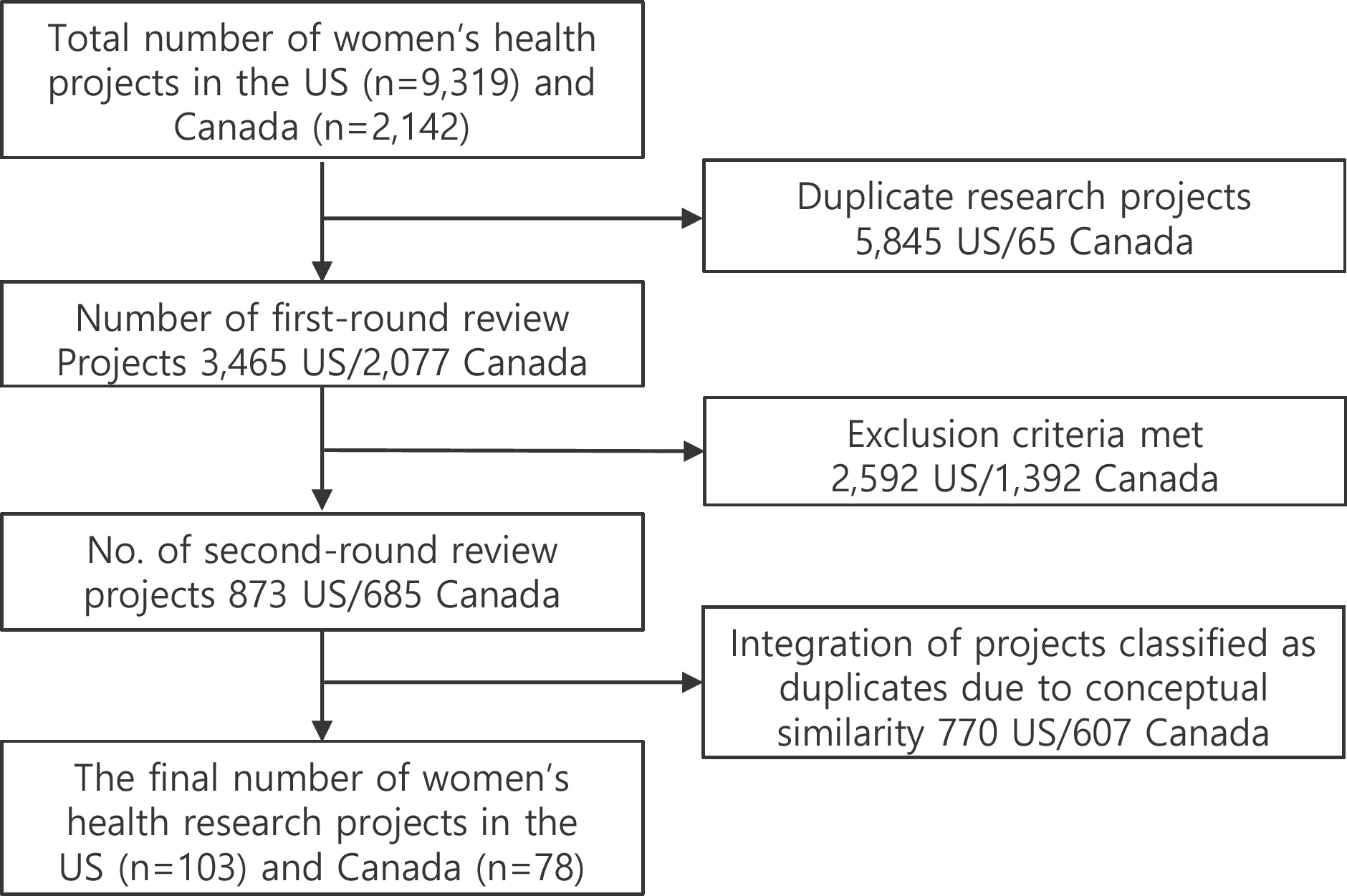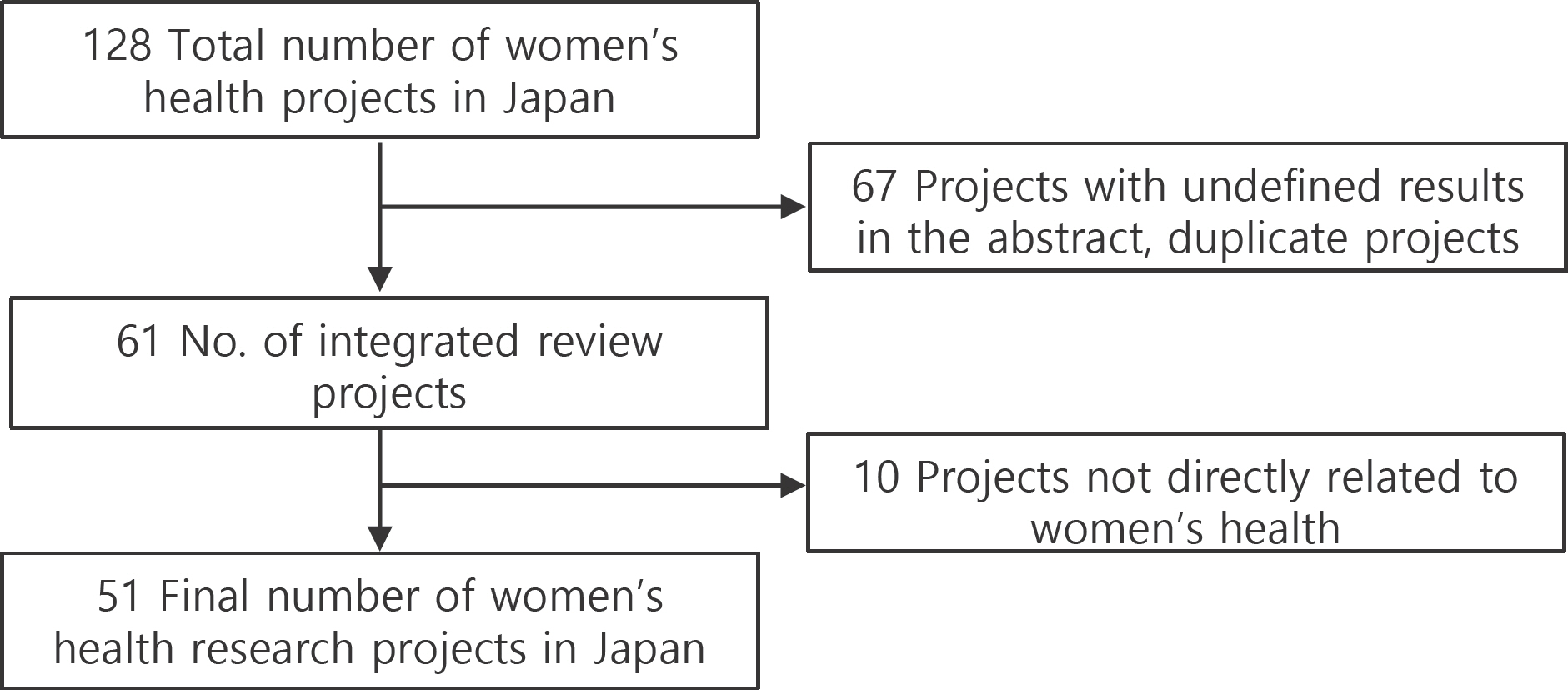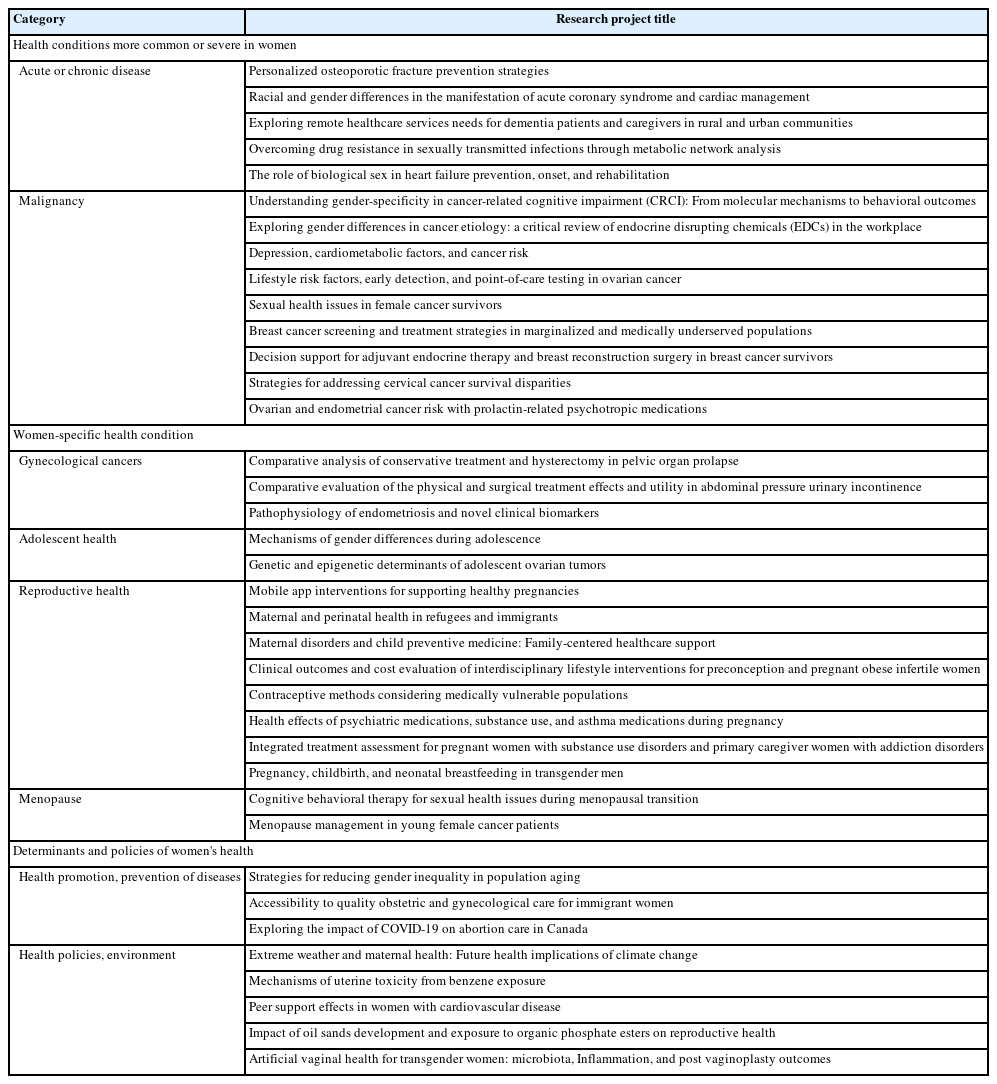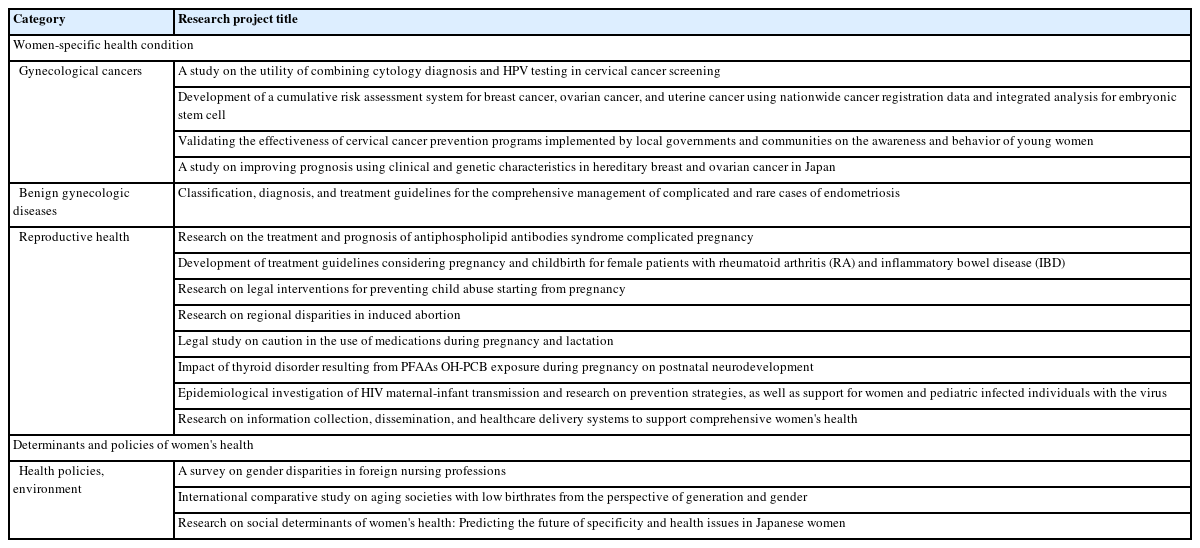국외 여성건강연구의 현황: 2012-2022년의 연구 과제 검색
Topics of Women's Health Research in the United States, Canada, European Union, and Japan in 2012-2022
Article information
Trans Abstract
Purpose
This study investigated recent trends in the topics of women's health research in the United States (US), Canada, Japan, and the European Union where various research projects related to women and gender have been conducted.
Methods
To explore recent international women's health research, we selected research projects conducted between 2012 and 2022 from the US National Institute of Health, Canada's Research Information System, Japan's Health, Labor and Welfare Science Research Performance Database, and the European Union's CORDIS website. We categorized the identified research into three main areas; common or serious diseases and conditions affecting women, diseases, and conditions specific to women, and factors influencing women's health.
Results
The focus of health research expanded beyond traditional views of women, gender, and gender differences. Projects addressed the health needs of vulnerable groups, including refugees, migrants, incarcerated women, trans individuals, and pregnant women with autism. They also explored the connections between gender and racial differences in women's health. This inclusive approach considered the gaps and intersections within women's health.
Conclusion
Future women's health research in Korea will need to consider the intersectionality of gender, aging, and immigration. Environment-based approach in the research of drug addiction, mental health, nursing, and care would be important.
서 론
최근 국내외로 성생식 건강과 같은 전통적인 여성건강의 범주를 벗어나는 지식 창출과 연구개발 수요가 증가하였다. 특히 기존 보건의료체계에서는 충분히 다뤄지지 않았던 여성의 특수한 건강 필요에 대응하는 연구 및 정책에 대한 요구가 여성 당사자와 조직화된 시민사회의 요청에 의해 가시화되었다. 낙태죄 폐지 전후로 생리대 등 월경도구의 안전성과 접근성 보장을 요 구하는 월경권, 피임과 임신 중단 등 재생산 건강 영역에서의 자기통제권 행사를 위한 의료서비스 보장 등 성재생산 건강권 보장에 관한 연구 수요도 증가하였다. 장애인, 이주민, 성소수자, 취약노동자, 노인 등 취약집단의 여성건강에 대한 중요성과 형평성 주류화 접근 방식을 통한 전략 마련의 중요성 역시 부각되고 있다. 코로나19와 같은 신종 감염질환의 병태 생리, 치료 효과, 예후 성차 연구는 더욱 강조되었다. 백신 도입 초반 안전성에 대한 여러 근거에도 불구하고 백신 부작용 평가체계 부재로 인해 많은 임산부들이 접종을 꺼리는 상황이 발생했다. 이 과정에서 코로나19 대유행과 같은 국제적 재난상황에서의 여성건강 영향과 포스트 코로나 시기 건강 영향 분석 및 예측의 필요성이 대두되었다.
오랜 기간 동안 여성은 가정 내 아동, 노인, 환자 돌봄의 주요 제공자의 역할을 수행했다. 지속적인 돌봄은 건강에 중요한 영향을 미치는 요인 중 하나임에도 불구하고 돌봄제공자로서의 여성건강은 기존 보건의료체계에서 소외되었다(Jadalla et al., 2020; Rha et al., 2015). 정밀의학기술 및 정보통신기술의 발전은 도입 속도에 비해 효과성, 안전성, 수용성 분석이 활성화되지 못했고 오히려 의료비용 증가의 추진력을 작용했다. 코로나19에 대한 실험실 연구와 임상연구에서는 다른 전염병과 달리 코로나19는 여성과 남성의 면역 반응 정도와 결과가 다르다는 것이 밝혀졌으며, 이는 이환율 및 사망률의 남녀 차이로 나타났다(Takahashi et al., 2020). 의료현장 자원 배분의 비효율성으로 인해 젠더 특이적 필수 의료서비스에 대한 접근성이 급격히 하락했다. 세계경제포럼에서는 코로나19 대유행 이후 성평등 격차가 39년 이전 수준으로 후퇴했다고 보고했다(Ghouaibi, 2021). 40개국 모성건강연구의 체계적 문헌고찰에서는 코로나19 대유행 시기 사산과 모성사망이 유의하게 증가했고, 저소득 국가에서는 부족한 피임서비스 제공으로 인해 700만 건 이상의 원치 않은 임신이 발생했다고 밝혔다(Chmielewska et al., 2021).
현재 여성건강에 대한 관심은 단순히 전통적인 문제에 그치는 것을 넘어 성생식 건강, 재생산 건강, 감염, 돌봄, 정신건강, 질환 등 다양한 분야의 전문적이 연구와 정책개발을 요구하고 있다. 여성건강연구를 오랫동안 진행했던 미국, 캐나다, 유럽 국가들이나 한국과 비슷한 문화적 맥락의 일본에서의 여성건강 연구 사례를 살펴봄으로써 향후 한국 여성건강연구에서 필요한 주제를 발굴하는데 참고할 수 있을 것이다. 이 연구는 급변하는 세대에 맞춰 오랫동안 여성과 젠더를 포괄한 다양한 보건의료 주제를 탐색해 온 미국, 캐나다, 일본, European Union (EU)의 최근 여성건강 연구동향을 고찰하고 이를 한국의 여성건강연구와 비교하여 국내 여성건강연구 추진방향을 설정하는데 있어 시사점을 제시하고자 하였다.
대상 및 방법
1. 자료원
한국, 미국, 캐나다, 일본, EU의 여성건강연구 현황을 조사하기 위해 Table 1의 자료원을 사용하였다. 최근 국외 여성건강연구의 주제를 탐색하기 위해 미국국립보건원 Research Portfolio Online Reporting Tools, 캐나다 연구정보시스템, 일본 후생노동과학연구성과데이터베이스, 유럽연합 Community Research and Development Information System (CORDIS) 웹사이트에서 2012년부터 2022년까지 수행된 여성건강 관련 연구 과제명을 검색하였다(Table 1).
2. 검색어 선정과 제외 기준
국외 여성건강에 관한 국가별 연구과제를 확인하기 위해 핵심 질문을 선정하고 이에 대한 검색어 리스트를 작성한 후 연구 수행 기간(2012-2022년)을 한정하여 연구과제 제목과 초록을 검색하였다. 여성건강 연구과제의 최대치 검색을 위해 성별(sex), 젠더(gender), 여성의 신체 특이적 단어, 생식 건강 혹은 재생산 관련 어휘들을 폭넓게 포함한 검색어 조합을 사용하였다(Table 2). 포함 기준은 검색어 리스트의 검색어 조합을 통해 확인된 연구 과제 중 여성건강 관련 주제이며, 제외 기준은 검색 결과 중 indigenous, Inuit, first nation, aboriginal이 대상인 경우, children, off-spring, fetal/fetus, neonatal 등과 같이 아기, 어린이 건강 영향을 위해 여성을 연구하는 과제였다. 1차 검색된 연구과제는 4인의 연구자가 서로 독립적으로 전체 과제 제목 을 검토한 뒤 제외 기준에 따라 2차로 선별하였다. 각 검토 결과를 교차로 재검토한 뒤 의견이 불일치하는 과제에 대해서는 연구진 간 반복 논의를 통하여 포함 여부를 결정한 뒤 최종 연구과제 목록을 합의하였다. 더불어 대마초 등과 같이 국내에서 사용이 금지된 약물 중독에 관한 연구, 중저소득 국가에 대한 국제보건 프로젝트 연구, 트렌스젠더 혹은 동성애자 중 주로 남성에게 초점이 맞춰진 연구, 트레이닝이나 세미나 등과 같이 이벤트성 과제나 기초연구를 위한 동물모델 개발 연구 역시 이 연구 대상에서 제외하였다.
3. 연구주제 분류
여성의 건강과 질병의 특성, 그리고 이에 영향을 미치는 특수 요인 및 결정 요인을 반영하기 위해 이 연구에서는 기존 연구에서 적용해 온 여성건강연구의 분류 기준을 참고하여 여성에게 더 흔하거나 심각한 질환 및 상태, 여성특이질환 및 상태, 여성 건강결정요인 및 정책의 세 가지 대분류를 사용하였다(Lim et al., 2014). 중분류는 검색된 연구과제의 주제를 기반으로 귀납적으로 분류하였다(Table 3). 성차(sex or gender difference)에 대한 결과는 생물학적 연구가 중심인 경우 여성에서만 나타나는 질환이나 상태로 분류하였고, 사회적 영향이 주요 내용인 경우 여성의 건강과 삶의 질에 중대한 영향을 주는 건강 요인으로 분류하였다.
결 과
1. 국외 여성건강연구 검색 결과
미국은 총 9,319건의 과제를 확인할 수 있었다. 이 중 중복과제 5,845건을 제외한 3,465건을 1차 검토 대상으로 선별한 뒤, 제외 기준을 충족하는 2,592건을 뺀 873건을 최종 검토 대상으로 분류했다. 이 중 개념상 유사하여 중복으로 분류할 수 있는 과제를 통합, 정리하여 최종 103건을 선정하였다. 캐나다는 총 2,142건의 과제를 확인할 수 있었다. 이 중 중복과제 65건과 제외 기준을 충족하는 1,392건을 제외한 685건을 최종 검토 대상으로 선별했다. 이 중 개념상 유사하여 중복으로 분류할 수 있 는 과제를 정리하여 최종 78건을 선정하였다. 일본의 경우 한글과 영문에 가장 가까운 의미를 뜻하는 일본어를 찾아 검색식을 구성한 뒤 연구과제를 확인하였다. 이 중 초록으로 검색결과를 확인할 수 없는 과제, 중복과제, 여성 및 젠더 건강과 직접적인 관련이 없는 77건을 제외한 51건을 최종과제로 선정하였다. 일본의 경우 확인할 수 있는 과제 수가 적어 초록으로 결과를 확인할 수 없는 과제와 여성건강과는 직접적으로 관련이 없는 과제를 제외한 모든 과제를 최종과제로 선정하였다. EU는 Horizon Europe이라는 7개년 과학연구 이니셔티브로 공동의 연구비 지원 프로그램을 운영하고 있어 하나의 단위로 분석하였다. 영문으로 확인할 수 없는 과제를 제외한 전체 건강 관련 연구 1,246건 중 제외기준을 충족하는 과제, 중복과제, 초록으로 연구 내용을 확인할 수 없는 과제를 제외하고, 개념상 유사하여 중복으로 분류할 수 있는 과제를 정리하여 최종 61건을 선별하였다(Figs. 1-3).
2. 국가별 여성건강 연구 분야 비교
미국에서 가장 비중 있게 다뤄지고 있는 여성건강 연구 분야는 여성특이질환(69.9%)으로, 이 중 성재생산 건강(36.1%)과 여성암(31.9%) 연구가 가장 많이 수행되었다. 반면 청소년기 건강에 대한 독립적인 과제는 확인할 수 없었다. 여성에게 더 흔하거나 심각한 질환 및 상태에 대한 연구는 전체 연구의 24.3%로 그 중 급만성질환(40%)에 대한 연구가 가장 많았다. 캐나다는 여성특이질환이 전체 연구의 53.8%로 가장 많았고, 여성에게 더 흔하거나 심각한 질환 및 상태(33.8%), 여성 건강결종요인 및 정책(12.5%) 순으로 조사되었다. 여성특이질환 내에서는 성재생산 관련 연구가 39.5%로 가장 많았지만 전반적으로 5개의 중분류 전체에서 연구가 진행되고 있었다. 일본의 경우 여성에서 더 흔하거나 심각한 질환 및 상태로 분류할 수 있는 연구는 확인할 수 없었다. 여성특이질환이 전체 연구의 68.8%로 높은 비중을 차지하였고, 그 중 여성암이 54.5%로 가장 많았다. 성재생산 건강(39.4%), 부인과양성질환(6.1%) 순으로 연구과제를 확인할 수 있었으나 청소년기 건강과 폐경기 건강에 대한 독립적인 연구 결과는 확인할 수 없었다. EU는 여성특이질환 및 상태가 전체 연구의 62.3%로 가장 많았고, 여성에서 더 흔하거나 심각한 질환 및 상태(26.2%), 여성 건강결정요인 및 정책(11.5%) 순으로 나타났다. 다른 국가들과 마찬가지로 여성암(47.4%)과 성재생산 건강(39.5%)의 연구가 가장 많았고, 폐경기 건강은 확인할 수 없었다. 여성에게 더 흔하거나 심각한 질 환에 대해서는 급만성질환이 81.3%로 가장 많았고, 암과 관련된 독립적인 연구과제는 확인할 수 없었다(Fig. 4, Tables 4-7). 일본을 제외한 국가들에서는 공통적으로 난민과 이주민 등 취약성이 집단과 성, 젠더, 인종에 기반한 격차연구 혹은 교차성을 포괄하는 연구 주제가 포함되었다. 대부분 두 가지 이상의 주제를 다루거나, 모바일 혹은 디지털 헬스 기술을 예방, 진단, 치료의 단계에 접목한 연구, 환자 만족도, 환자 중심성, 코로나19 팬데믹 기간의 환자 고립에 대한 연구도 확인되었다.
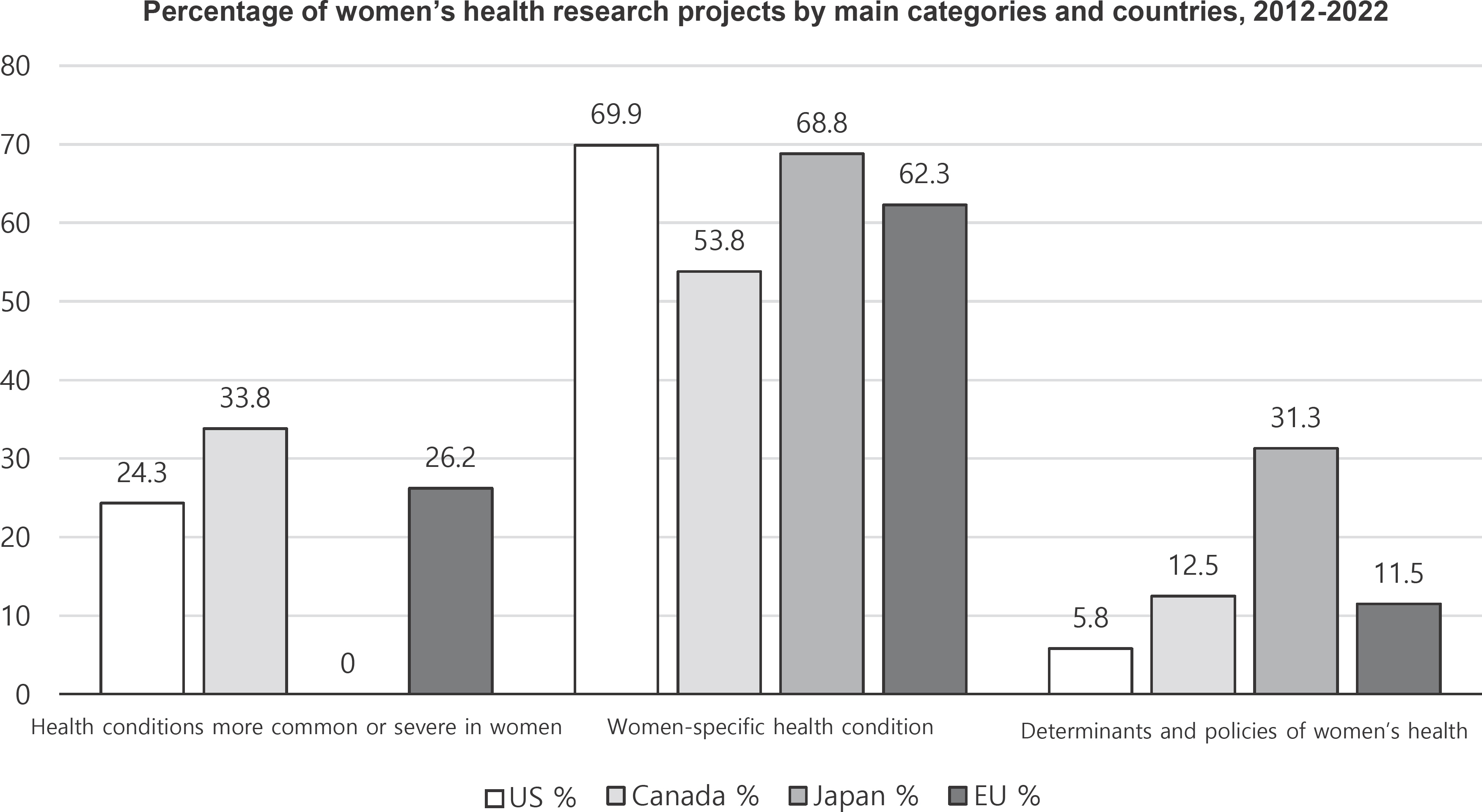
Percentage of women's health research projects by main categories and countries, 2012–2022. US, United States; EU, European Union.
고 찰
이 연구는 2012년부터 2022년까지 미국, 캐나다, 일본, EU 의 여성건강 연구과제를 검토하여 각 국가의 연구 영역을 개괄하였다. 미국, 캐나다, 일본에서 공통적으로 가장 비중 있게 다뤄지고 있는 여성건강 연구분야는 여성특이질환이었다. 미국과 캐나다, EU에서는 성재생산 건강 연구와 정책 연구, 여성암 연구의 비중이 비슷한 반면, 일본에서는 여성암 연구가 월등히 많았다. 국외 여성건강연구는 전통적인 여성, 젠더, 성차와 같이 단면적 건강 대상을 확장하여 난민과 이주민, 수감자 여성, 트랜스 여성 혹은 남성, 자폐가 있는 임산부와 같이 취약성이 큰 특수집단과 성, 젠더, 인종 차이에 기반한 격차연구 혹은 교차성을 포괄하는 연구 주제가 포함되었다. 만성질환 혹은 정신질환과 같이 단일 주제나 질환보다는 대부분 두 가지 이상의 주제를 포함한 융합적 연구가 진행되었으며, 질병 예측, 예방, 치료, 관리 등 각 중재 단계별로 모바일 혹은 디지털 헬스 기술을 접목한 연구도 확인할 수 있었다. 새로운 의료기술 개발 연구가 연구 대상 국가들에서는 주로 서비스와 관리 차원에서 활용되는 경우가 많은 것을 확인할 수 있었으며, 질병이 아닌 건강 관련 상태(만족도, 환자 중심, 고립 등)에 대한 혼합연구도 증가하는 추세였다. 이렇게 각 국가별로 특색 있는 여성건강연구가 진행될 수 있었던 배경에는 이러한 연구를 지원하는 조직과 이니셔티브가 뒷받침 되었기 때문이다.
미국은 National Institutes of Health (NIH), Centers for Disease Control and Prevention, U.S. Food and Drug Admini-stration, Agency for Healthcare Research and Quality 등에 여성전담조직이 구성되어 있다. 이 중 NIH에 1990년 설립된 Office of Research on Women's Health (ORWH)는 건강과 질병 분야에서 여성건강을 증진시키기 위해 생물학적 성과 사회적 성에 따른 생명, 의료, 행태 연구를 지원하며, 여성건강연구가 보건의료분야 연구의 과학적 체계 일부가 될 수 있도록 NIH 산하기관들과 협력하고 있다(Kim et al., 2013). ORWH는 여성건강과 관련된 정책적 제언을 제공하며, 여성에게 영향을 미치는 질병, 질환, 생활 여건 등과 관련된 연구를 강화하는 역할을 수행한다. 또한 NIH가 지원하고 실시하는 연구들이 여성이 대상이 되고, 여성건강과 관련된 이슈를 충분히 다룰 수 있도록 지원하고 있다. 더불어 과학기술 연구에 있어서 여성의 경력개발 기회를 제공할 뿐만 아니라 여성특이질환에 대해서는 직접적인 연구지원을 담당하고 있다. 2021년 ORWH는 여성건강증진을 위한 NIH 연구 고도화를 주제로 모성이환율 및 사망률 증가와 관련된 임상진료, 여성에서 만성 장애 상태 비율의 증가, 침체된 자궁경부암 환자의 생존율을 주요한 3가지 이슈로 다뤘다(National Institutes of Health, 2021).
캐나다의 Canadian Institutes of Health Research 젠더건강연구소는 전 세계 유일한 성과 젠더건강을 내세운 연구기관으로 특히 과학 및 보건의료 연구에 있어 세포의 성(sex)과 개인의 성별(gender)을 고려하는 혁신적인 연구를 주도하고 있다(Canada Institutes of Health Research, 2023). 젠더건강연구소는 통합, 혁신, 영향을 핵심전략으로 제시하며 단순한 연구지원 기관을 넘어 정책 결정과 규제에서도 영향력을 발휘하고 있다. 연구 대상자 역시 ‘여성’으로 한정하는 것이 아니라 남성과 소녀, 젠더와 성별 구분이 다양한 사람들로 확장하고 이들의 건강을 증진시키기 위해 지식의 빈틈을 메우는 것을 목표로 하고 있다. 이는 캐나다에서 특히 건강증진 정책 및 프로그램에 대한 연구가 많은 것을 설명할 수 있다.
일본의 경우 의료 취약지에서의 성재생산건강관리 서비스나 남성 간호사에 대한 연구 등 향후 한국에서 참고할 만한 여성건 강 관련 연구 주제들을 참고할 수 있었다. 그러나 미국, 캐나다, EU와 비교했을 때 일본의 여성건강연구에 대해서는 한정된 과제만 확인 가능했다. 후생성 홈페이지에서는 Table 2와 같은 광범위한 검색어를 사용하여 연구과제를 검색하는 것이 불가능했기 때문에 여성건강과 관련된 제한된 검색어를 사용하되 최대한 폭넓게 관련된 주제를 확보하여 분석하였다.
유럽위원회(European Commission, 2020)의 Horizon 2020 Research and Innovation은 보건의료분야 연구의 주요 이슈로 다음의 6가지를 제시하고 있다(CORDIS). 첫째, 인구학적 변화와 인구 고령화; 둘째, 자원을 효율적으로 사용해야 하는 필요성 증가; 셋째, 의료전문가의 새로운 기술에 대한 수요; 넷째, 건강 문제의 세계화; 다섯째, 비전염성 질병의 유행; 여섯째, 치료에서 예방으로 초점 전환. 더불어 EU는 젠더 연구와 혁신을 촉진하기 위해 사회, 경제, 환경, 생물학적 고려를 포함해 연구에는 성별과 젠더, 연령을 구분한 자료를 사용하고, 이러한 차이를 탐색하는 연구에 연구비를 지원할 것을 강조하고 있다. 또한 여성, 아이, 노인을 팬데믹 대응, 예방, 치료 연구에 포함하고, 보건기술 평가와 규제에 성별과 젠더를 기준으로 포함하며 새로운 이니셔티브와 건강 관리 도구를 개발할 때 백신과 약물의 임신 중 사용 안전성에 대한 연구 포함할 것을 명시하고 있다. 더불어 모든 연구와 혁신에 참여하는 보건전문가와 과학자들의 다양성을 반영해야 한다는 것을 강조했다.
국외 연구과제에 비해 국내에서 덜 다루어진 연구주제를 확 인하기 이해 보건복지부 지원 여성건강 연구과제를 비교하였다. 급만성질환은 국내외 공통적으로 골다공증, 골절, 심혈관계 질환, 갑상선 기능 이상과 당뇨에 대한 연구과제를 확인할 수 있었으나 급만성질환에서의 성차 연구는 캐나다에서만 확인할 수 있었다. 국내 과제에서는 주로 여성 비뇨기계 질환에 대한 연구가 많았고, 국내에서 진행된 대부분의 연구과제는 발생 기전보다 예방과 치료 등에 관한 T2 분야의 중개연구였다. 정신질환은 국내외 공통적으로 우울증과 치매에 관한 연구가 많았다. 그러나 국내의 경우 여성의 치매, 특히 알츠하이머병의 기전과 그 전 단계 인지노화와 같은 연구 과제는 확인할 수 없었다. 우울증과 식이장애에서도 발병 기전에 대한 T1 연구보다는 예측 요인과 관리에 대한 T2 연구가 더 많았다. 국내외 모두 유방암에 대해서는 T1, T2 연구가 활발히 진행되었는데, 그 중에서도 특히 국내에서 새로운 바이어마커나 면역치료제와 같은 신기술 연구가 많았다. 유방암을 제외한 종양 연구에서는 난소암, 자궁내막암 과 같은 생식기계암을 확인할 수 있었고, 이러한 연구는 특히 국내에서 가장 활발히 이뤄졌다. 이는 생식기계암의 질병 부담이 한국보다는 주로 미국, 캐나다, EU에서 더 높은 것과 대조적인 결과였다. 가임력과 관련해서는 한국에서 인공 난소나 난자 동결보존과 같이 응용 치료 기술 연구가 활발한 것과 대조적으로 EU와 캐나다에서는 재생산 관련 의사결정이나 생식 건강의 영향 요인, 맞춤형 가임력 치료 프로그램과 같이 환자 중심 서비스 연구가 많았다. 건강 증진과 예방, 정책 및 제도 연구는 한국에 비해 분석 대상 국가들에서 다양한 사회계층과 연령층에 대한 연구가 많은 것을 확인할 수 있었다. 특히 일본에서 노인 여성의 건강과 노화를 키워드로 하는 서비스, 사회정책 연구가 시행되었다. 국내 연구의 경우 성소수자, 이주여성, 간병인, 청소년, 여성근로자 등 전통적인 관점에서 연구의 범주 안에 포함되지 못한 여성인구집단에 대한 연구가 점진적으로 진행되고 있었으나 여전히 제한적인 영역에서만 진행되고 있었다. 더불어 국내 연구의 경우 여성의 정서적, 심리적 영향에 대한 연구보다는 기술 개발, 치료 등에 관한 연구과제에 집중되었다. 더불어 비교적 최근 연구의 중요성이 대두되고 있는 정신건강, 약물중독, 감염, 간병 및 돌봄 등에 관한 연구는 미흡한 실정이다.
이 연구는 본질적으로 검색 결과가 해당 국가에서 시행된 전체 여성건강연구 과제의 목록을 포괄할 수 없다는 한계가 있다. 특히 EU와 일본의 경우 영어로 식별할 수 없는 과제는 검토 대상에서 제외했기 때문에 여성건강과 관련 있는 과제임에도 불구하고 이 연구의 분석 대상에 포함되지 않았을 가능성이 있다. 특히 일본의 경우 후생성 과제로 검색 범위를 하였으므로 실제 일본에서 수행되고 있는 여성건강연구과제를 축소하여 제시했을 수 있다. 미국과 캐나다와는 대조적으로 EU 및 일본에서의 연구과제 검토는 언어적 제약 외에도 웹 검색 결과의 차이로 인해 연구과제를 선정하고 분류하는데 있어 동일한 검토 수행과정을 따르지 못했다. 또한 4개 국가 모두 연구주제의 분류를 제목과 초록을 기반으로 하였으나 초록이 프로젝트의 내용을 완전히 반영하지 않을 경우 잘못된 분류로 이어질 수 있을 가능성이 있다. 그럼에도 불구하고 이 연구에서는 연구자 간 교차검증을 통해 연구과제를 분류하는데 있어 발생할 수 있는 문제를 최소화하고자 하였다.
결 론
향후 한국의 정부 지원 여성건강연구가 변화하는 한국 여성의 건강 수요를 반영하기 위해서는 여성건강연구의 전담 지원 조직 아래 약물중독과 정신건강, 간병 및 돌봄 등 재생산 건강을 넘어선 다양한 연구 주제를 포괄하면서 젠더, 연령, 인종, 이민 등과 같은 교차성을 고려할 필요가 있을 것이다.
Notes
저자들은 이 논문과 관련하여 이해관계의 충돌이 없음을 명시합니다.
감사의 글 및 알림(ACKNOWLEDGMENTS)
이 연구는 국립보건연구원 연구개발과제(2022-ER0606-00)와 고려대학교 연구개발과제(K2022961) 연구비를 지원받 아 수행되었습니다.




